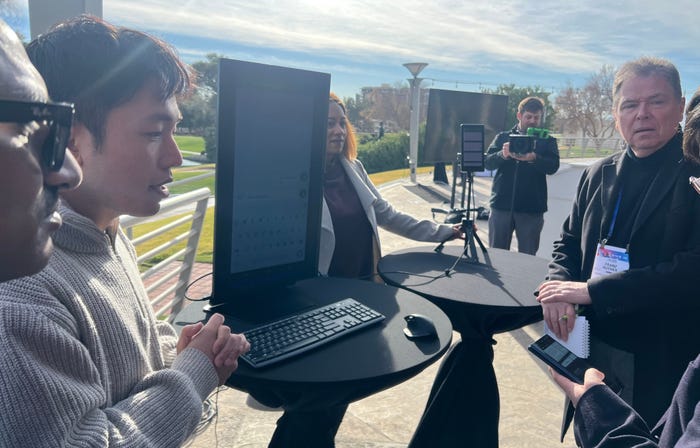AST SpaceMobile gets OK from FCC to test sat-to-phone tech with AT&T in U.S.AST SpaceMobile gets OK from FCC to test sat-to-phone tech with AT&T in U.S.
.jpg?width=1280&auto=webp&quality=95&format=jpg&disable=upscale)
AST SpaceMobile—a LEO satellite company that plans to deliver broadband cellular service directly to unmodified wireless devices—has received an experimental license from the FCC to conduct tests this year in preparation for launches that are expected to result in continuous global coverage by the end of 2025, a company official said.
Scott Wisniewski, chief strategy officer and executive vice president for AST SpaceMobile, said the FCC experimental license will let the low-earth-orbit (LEO) satellite startup test its 693-square-foot BlueWalker 3 satellite (pictured above) for about six months in parts of Texas and Hawaii. AST SpaceMobile also has secured similar regulatory approval in Kenya and is seeking permissions to conduct testing in other countries, he said.
“This is our second test satellite,” Wisniewski said during an interview with IWCE’s Urgent Communications. “This will be our first big satellite that we’ll put into space. It’s still smaller than our production satellites, but it’s a big satellite.”
Indeed, the AST SpaceMobile production satellite—known as the BlueBird, the first of which is scheduled to be launched next year—will be 20 meters by 20 meters, or more than 4,300 square feet.
“The size is important,” Wisniewski said. “Because, in order to communicate over the noise floor with a small phone with small power, small antenna and small gain, you need something big—that’s our view. And the bigger it is, the more [data] throughput—it’s really just a function of area—so we’ve designed the satellites to be big.”
AST SpaceMobile plans to deploy its BlueBird constellation in a phased approach that will let the company offer complementary broadband services to customers of wireless carriers throughout the world by the end of 2024, as well as MIMO capabilities in key markets by the end of 2025, according to Wisniewski.
“Twenty satellites gets us continuous equatorial coverage,” he said. “Another 45 gets us initial coverage in certain geographies, and then another 45 after that gets us substantially global coverage. So, 110 satellites gets us substantially global coverage.
“We have, in our business plan, another 60 after that. That layers in MIMO for important markets like the U.S., Japan and Europe.”
AST SpaceMobile plans to provide MIMO support via 170 satellites by the end of 2025, Wisniewski said.
Unlike other higher-profile LEO satellite companies—for example, Starlink or OneWeb—AST SpaceMobile does not require users to deploy special satellite receivers to communicate. Instead, AST SpaceMobile satellites can connect directly with unmodified smart devices, acting as a cell-phone tower about 300 miles above the earth’s surface.
“The phone sees it [the AST SpaceMobile satellite] as another tower,” Wisniewski said, noting that AST SpaceMobile plans to serve as a complementary roaming partner to cellular carriers, with the idea of ensuring that customers maintain connectivity at all times.
This BlueWalker 3 testing will mark the first time that AST SpaceMobile has conducted a traditional test of its direct-to-phone satellite technology. AST SpaceMobile has proven the concept works during a “inverse” test conducted in 2019, during which a cell phone was put on a LEO satellite and demonstrated the ability to communicate with a satellite that was deployed at the AST SpaceMobile facility in Midland, Texas.
This initial test was the basis for funding support that AST SpaceMobile received in its Series B investment from companies like Vodafone, Rakuten, American Tower and Samsung, Wisniewski said.
AST SpaceMobile plans to conduct BlueWalker 3 tests with Rakuten in Japan, with Orange in Africa, and with Vodafone in Europe and Africa, Wisniewski said.
AST SpaceMobile officials declined to name the carrier it will work with to conduct tests in U.S., but the FCC experimental license identifies spectrum bands used by AT&T—including some 700 MHz Band 14 frequencies licensed to the FirstNet Authority for FirstNet, the nationwide public-safety broadband network (NPSBN).
AT&T confirmed to IWCE’s Urgent Communications that it is participating in the BlueWalker 3 testing.
“We are happy that the FCC has approved AST SpaceMobile’s application,” according to a prepared statement provided by AT&T. “We are looking forward to working with AST to test this technology.”
Many in the critical-communications industry have been monitoring closely the progress made by AST SpaceMobile and Lynk Global, another LEO-satellite company that plans to partner with wireless carriers to provide cellular service directly to unmodified smart devices located outside of terrestrial-network coverage.
If these direct-to-phone technologies are successful, it would provide LTE and 5G devices with the kind of graceful transition that has been lacking for first-responder use. In addition, the LEO-satellite-to-cellular-phone connectivity could allow people in need of help call 911, even when they are outside of a carrier’s terrestrial-network footprint.
With its larger satellite, AST SpaceMobile plans to be able to operate on carrier’s low-band spectrum, as well as mid-band spectrum up to 4 GHz.
“We believe we can operate up to C-band,” Wisniewski said.





